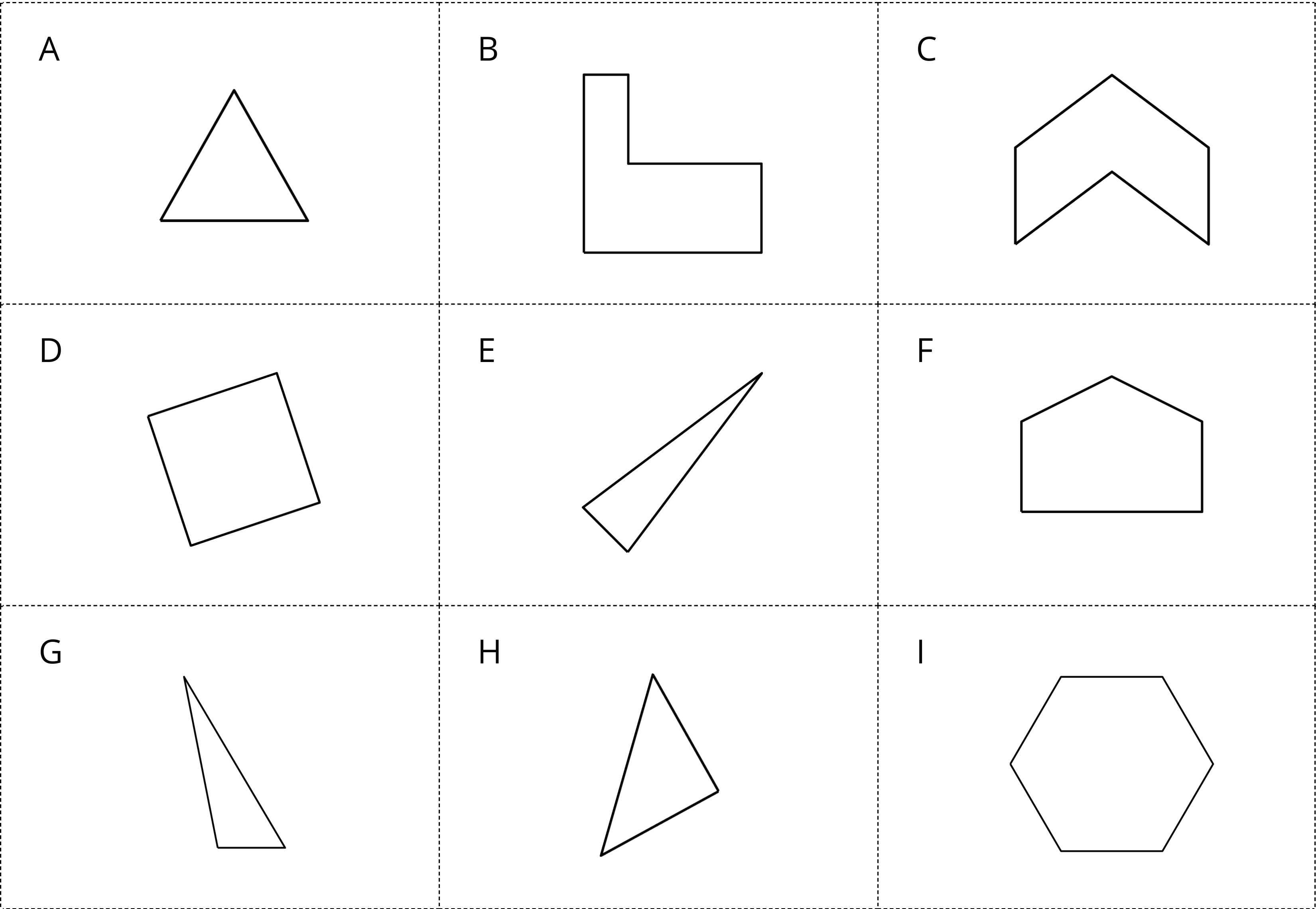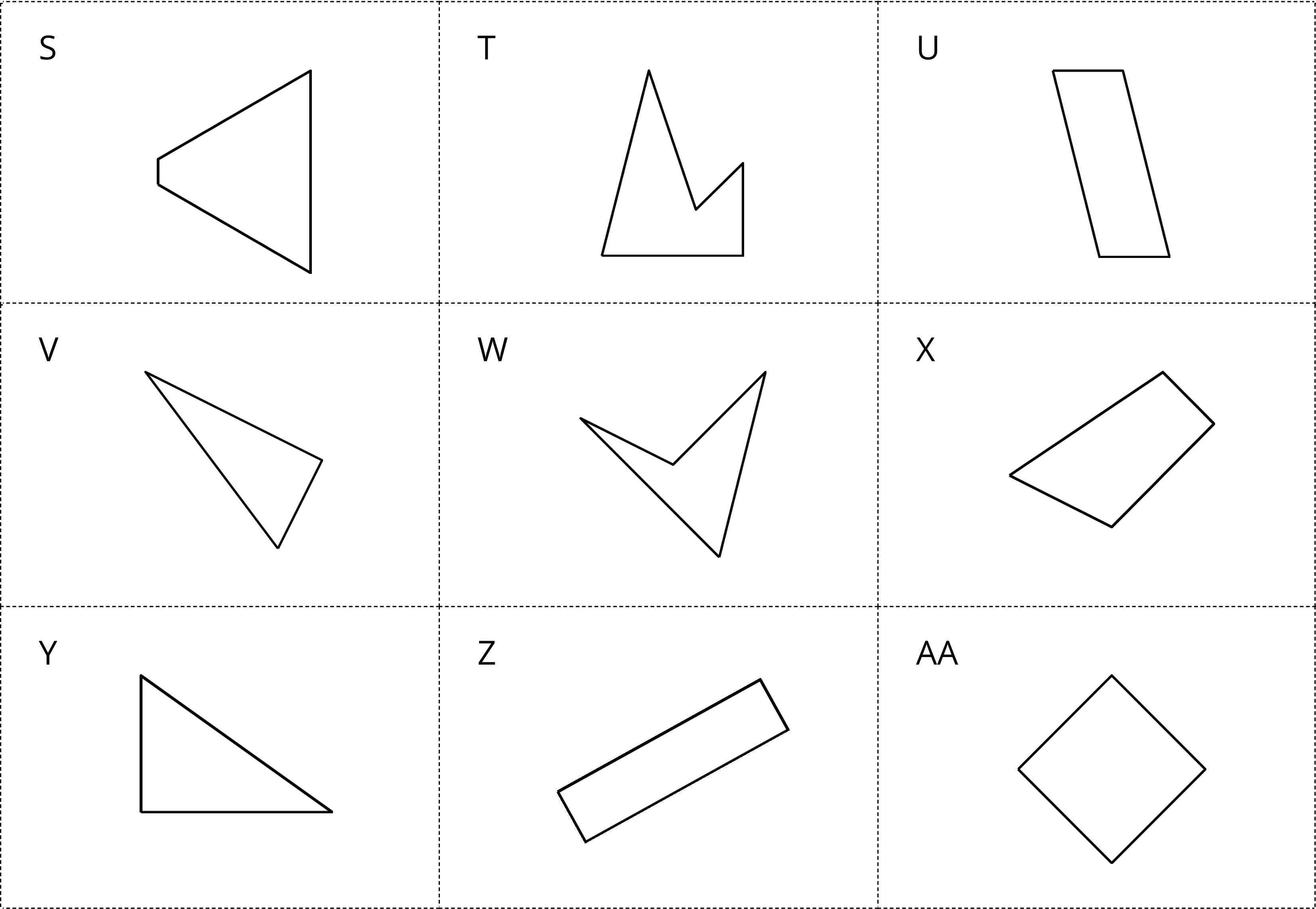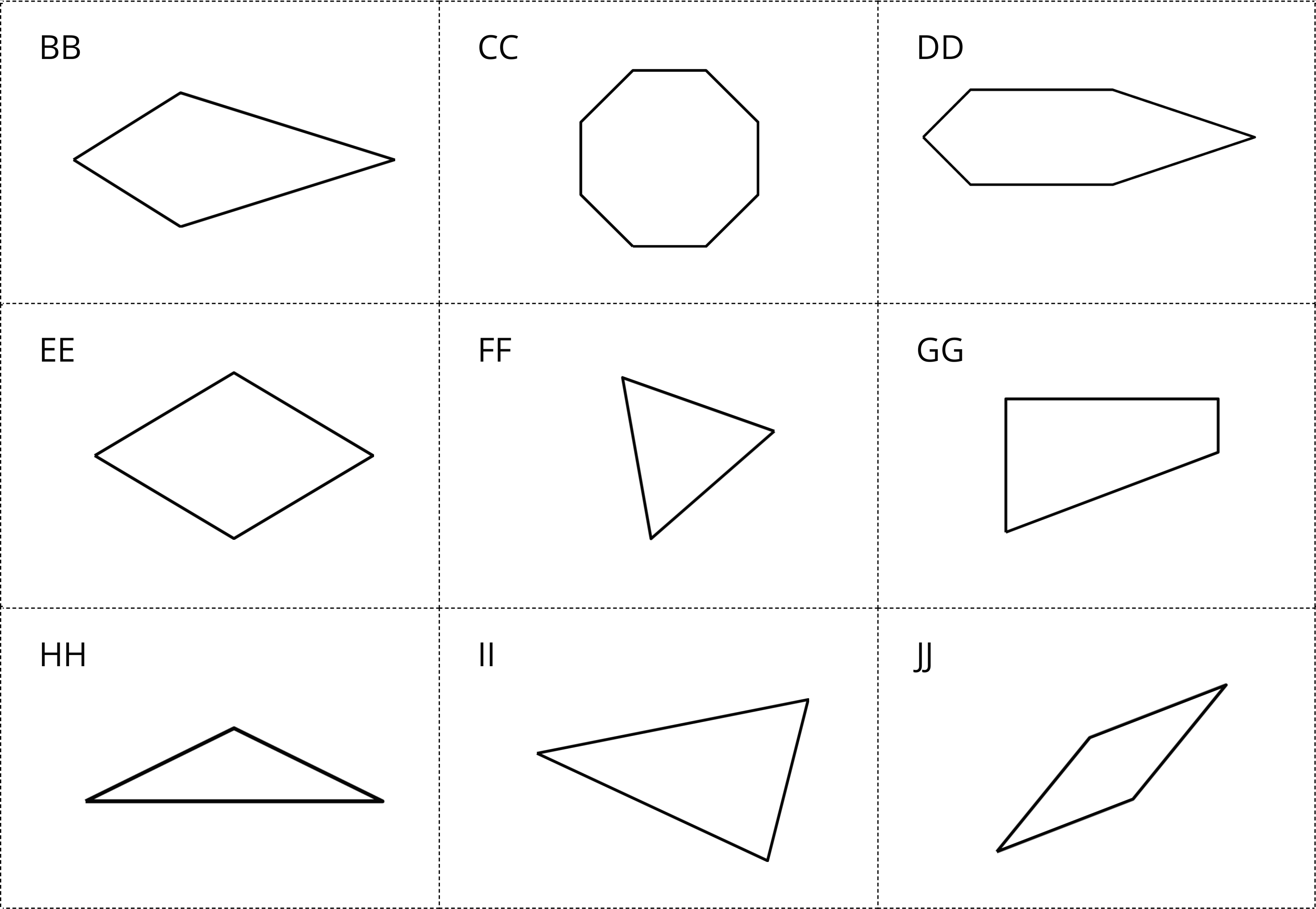Lesson 1
Ways to Look at Figures
Warm-up: Which One Doesn’t Belong: Geometric Figures (10 minutes)
Narrative
This warm-up prompts students to compare four geometric figures. It encourages students to carefully examine each figure and to use language precisely (MP6). It also gives the teacher an initial opportunity to hear the terminology students use to describe and compare the attributes of two-dimensional figures and to make comparisons. When students explain their thinking, ask them to clarify the terminology they use. For instance, if they say, “same sides” or “square corners,” urge them to elaborate on what each phrase means.
Launch
- Groups of 2
- Display the image.
- “Pick one that doesn’t belong. Be ready to share why it doesn’t belong.”
- 1 minute: quiet think time
Activity
- “Discuss your thinking with your partner.”
- 2–3 minutes: partner discussion
- Share and record responses.
Student Facing
Which one doesn’t belong?

Student Response
For access, consult one of our IM Certified Partners.
Activity Synthesis
- “What attributes of the figures did you pay attention to as you tried to find a figure that did not belong?”
- Consider saying:
- “Let’s see if we can find at least one reason why each one doesn’t belong.”
Activity 1: Card Sort: Shapes (20 minutes)
Narrative
In this activity, students analyze a set of 36 two-dimensional shapes, choose an attribute for classifying the shapes, and then sort them into several categories. After sorting, students have opportunities to test and refine their decisions—first by discussing their categories with another group, and then by removing the labels of their categories to see if a second group of peers could identify how the shapes are sorted. To encourage students to think beyond two categories (for example, “triangles” and “not triangles”), the task specifies 3–5 categories.
During synthesis, collect the categories that students generate. Students will likely use informal language in describing their categories (for example, “they have all the same sides” or “the sides are slanted the same way”). Encourage students to use more precise mathematical language (MP6) and support them in doing so by revoicing their ideas (for example, “all sides have the same length” for “all sides are the same”).




This activity uses MLR2 Collect and Display. Advances: Conversing, Reading, Writing
Supports accessibility for: Social Emotional Functioning
Required Materials
Required Preparation
- Create a set of cards from the blackline master for each group of 2–4.
Launch
- Groups of 2–4
- Give a set of 36 cards (from the blackline master) and 8–10 sticky notes to each group.
- Provide access to rulers and protractors.
Activity
- “Work together to sort the cards into 3–5 categories. There are many ways to do this, but the cards in each group should go together for a specific reason. Be prepared to explain your reason.”
- “For each category, write a label that describes why the figures belong together.”
- “You may use the portable word walls you created. We will continue to add new vocabulary to them during the lessons in this unit.”
- Circulate and collect the language students use to describe and sort the shapes. Listen for: parallel lines, types of angles, number of angles, and number of sides.
- Record students’ words and phrases on a visual display and update it throughout the lesson.
- 5 minutes: group work time
- 5 minutes: Discuss sorted figures with another group.
- “Now, cover or hide the labels of your categories and then visit a different group.”
- “Study their sorted shapes and try to guess the categories. Write your guess for each category on a sticky note.”
- 3 minutes: Guess another group’s categories.
Student Facing
- Sort the shapes from your teacher into 3–5 categories. For each category, write a title on a sticky note.
-
Share your categories with another group. Take turns listening to each other’s explanations.
- Do your categories make sense to them?
- Do their categories make sense to you?
- Any suggestions or corrections?
-
Cover or hide the titles of your categories. Trade places with another group. Study their sorted cards while they study yours.
Guess their categories and how they sorted the shapes.
Student Response
For access, consult one of our IM Certified Partners.
Activity Synthesis
- “What were some of the categories you used to sort the shapes?”
- As students share responses, update the display by adding (or revising) language, diagrams, or annotations.
- Point out to students that some categories had to do with the sides of the shapes and others had to do with the angles.
- Remind students to borrow language from the display in the next activity.
Activity 2: Guess the Category (15 minutes)
Narrative
In the first activity, students sorted a given set of shapes based on one or more attributes. In this activity, they continue that work in groups of two. Quietly, one partner chooses a geometric attribute, defines a category (for instance, “shapes with no parallel sides”), and finds several shapes that fit and don’t fit the category. The other partner makes a conjecture about what the category is, first by looking for a common attribute in the given examples (or absence of a common attribute in the non-examples), and then testing a few more shapes that they think belong or don’t belong. Consider playing a quick round as a class to clarify directions.
As students look for an attribute shared by one set of shapes but not by another, they identify a mathematical property or structure (MP7).
Launch
- Groups of 2
- Read the task statement as a class. Clarify the directions as needed.
- Display the list of attributes students used to sort figures in the previous activity.
- “You may choose to use an attribute from this list or consider a new attribute that has not yet been used.”
- As needed, challenge students to describe the attributes of shapes using the vocabulary learned in a previous unit.
Activity
- “Play two rounds of Guess the Category with your partner. Switch roles for the second round. Write down the correct category at the end of each round.”
- Consider playing a round with the entire class to demonstrate the game.
- If time permits, encourage students to play another round.
Student Facing
Partner A:
- Write down a category from the first activity (or think of a new one). Don’t show it to your partner.
- Find 3 shapes that fit the category and 3 shapes that don’t. Place them in the columns of the table.
Partner B:
- Study the shapes chosen by your partner.
- Pick another shape from the set. Ask: “Does this shape fit in your category?”
- Find 2 shapes that fit the category and 2 shapes that don’t.
- Guess the category. If your guess is off, ask more questions before guessing again.
Switch roles after the category is guessed correctly.
-
Partner A’s category:
\( \underline{\hspace{7cm}}\)
| fit the category | do not fit the category |
|---|---|
| \(\phantom{\hspace{2.5cm} \\ \hspace{2.5cm}}\) | \(\phantom{\hspace{2.5cm} \\ \hspace{2.5cm}}\) |
-
Partner B’s category:
\( \underline{\hspace{7cm}}\)
| fit the category | do not fit the category |
|---|---|
| \(\phantom{\hspace{2.5cm} \\ \hspace{2.5cm}}\) | \(\phantom{\hspace{2.5cm} \\ \hspace{2.5cm}}\) |
Student Response
For access, consult one of our IM Certified Partners.
Advancing Student Thinking
Students may guess an attribute that is true for all the given shapes but does not match the attribute their partner was thinking. Refer students to the chart of ideas from the first activity and their personal word wall. Consider asking:
- “How might the words or phrases from our chart or your word wall help you think about categories or attributes?”
- “What other attributes do these shapes share?”
- “What other questions could you ask your partner to get a clue about the attributes they had in mind?”
Activity Synthesis
- “Who used a brand new category while playing? What was it?”
- Add any new categories to the list from the first activity, again organizing by attribute.
Lesson Synthesis
Lesson Synthesis
“Today we sorted figures based on the different attributes they have. We learned we can classify or group two-dimensional figures a variety of ways.”
“What are some ways to group using the sides of the figures?” (number of sides, length of sides, presence of parallel and perpendicular sides)
“What are some ways to group using the angles in the figures?” (number of angles, size of angles, presence of right angles, obtuse angles, or acute angles)
“Let’s continue to add new vocabulary to our word walls from the last unit. Take 1–2 minutes to add any new words from today’s lesson to your word walls.”
“We will continue to think about different attributes of two-dimensional figures and how they could help us better understand the figures.”
Cool-down: What Do They Have in Common? (5 minutes)
Cool-Down
For access, consult one of our IM Certified Partners.